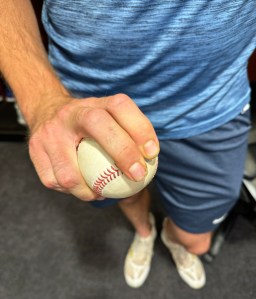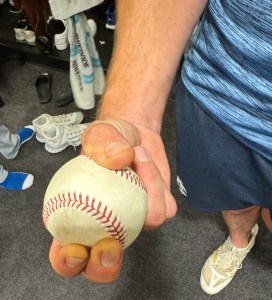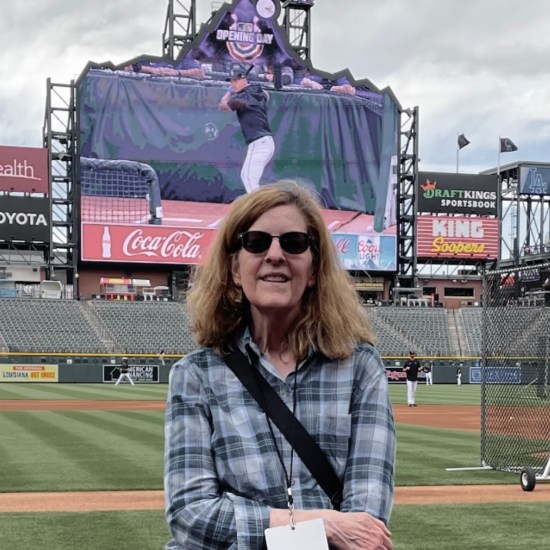Pitcher List Conversations are transcripts of interviews with professional baseball players—and sometimes, players discuss topics other than baseball. This has been lightly edited for clarity.
This is the first of two interviews with Kansas City Royals pitching staff. I want to thank Kansas City Star reporter Jaylon Thompson, who shared his insight on the team. Jaylon told me about the starters’ approach to pitching as a kind of “workshop/lab.” That notion informed some of the questions I asked.
★ ★ ★
When I visited the Kansas City Royals in the visitors’ clubhouse at Coors Field on Sunday, July 7, the air was buzzing.
The team had just revealed to the media their All-Star selections with stories strictly embargoed until MLB made the announcement official later in the day. By the time I arrived, reporters had spoken with Bobby Witt Jr. and Cole Ragans, and they were interviewing Salvador Perez. Next on the list was Seth Lugo, who was also my target.
“It’s pretty cool,” Lugo said of being selected
Given that he had entered the season determined to redefine himself as a starter, the fact he was selected in that capacity was especially meaningful.
“Coming up, I didn’t think I would be here at this stage of my career. It’s not the journey I thought I was going to be on,” Lugo said. “But I knew younger my career that I could sustain some stuff. I could play later in my life. I knew that age wasn’t an issue. So, you know, a little bit of perseverance and determination. It’s a good feeling.”
He was also pleased for his teammates. “I’m happy that there’s multiple All-Stars on this team. That’s pretty cool,” he said.
And while Cole Ragans had needed to call his wife and ask her to bring his suit, Lugo was prepared.
“I’ve had mine with me,” he grinned.
After the media scrum ended, Seth Lugo was good enough to answer a few questions for me.
★ ★ ★
Renee Dechert: Nick Pollack and Eno Sarris chatted about your arm angle changes this year, and being able to throw all of your pitches from these arm slots. Can you go into more detail about what you feel more comfortable with?
Seth Lugo: As a kid, I played more infield than outfield, so I feel more comfortable with a three-quarter arm slot. But I know from an outfielder standpoint to stay behind the ball, get a little more true carry on the throw — that’s the fastball. But I know I have to throw some other pitches out of that arm slot to blend and not tip my pitches. So, the more natural is the three-quarter, but I’ll come up a little bit and drop a little bit just to add some more horizontal movement.
RD: What’s the new cutter grip that you’re using?
Seth Lugo cutter:https://t.co/Tn4um1vzTk
— Renee Dechert (@ReneeDechert) July 9, 2024
SL: Actually, when I came into Spring Training this year, Zach Bove showed me a grip, and that’s the one I’m using. That’s a more consistent break. It’s kind of a quarter-turn on the four seam. But it’s Zach Bove’s grip.

RD: Given the number of pitches in your arsenal, how do you go about planning for your starts? What do you throw to which hitter?
SL: My whole game plan is established on who I’m facing, so it depends on the batters. It’s strictly on their weaknesses and how I want to establish my pitches in the zone.
RD: How do you make in-game adjustments, then?
SL: That’s a little trickier. I obviously rely on results — the swing path — but I rely on Salvie and Freddie and Sweeney to [tell me] “What pitch’s breaking better today?” You know, “Which one am I getting to execute better than the others?”
So it’s a group effort when it comes to that.
RD: Could you talk a bit about your curveball? I mean, that’s an elite pitch.
SL: Well, that’s that’s the same same grip I’ve thrown since I was about 10. So that’s my pitch.

RD: What are your cues for that one?
SL: Just try to spin it. That’s it.
RD: You’ve been pretty successful at that. How do you maintain that spin rate?
SL: It’s literally, when I when I throw it, I’m just thinking spin it as best as I can. That’s the way I learned how to throw it when I was 10, and I’m still doing it.
Seth Lugo, 3503 RPM Curveball. 🌪️ pic.twitter.com/15T1BoWxC3
— Rob Friedman (@PitchingNinja) June 30, 2024
RD: Speaking of Sal Perez, what’s it like to have him catch your games?
SL: It’s great. He’s a big target. I know when he calls a pitch, trust that pitch. He’s one of those guys that encourages everyone to be their best, but he’s one of those guys that I feel like he wants everyone else to have success.
RD: Clearly this rotation, in talking to Cole Ragans and Michael Wacha, you all have developed a sort of laboratory-workshop approach as a starting rotation. How does that work? What do you take from that?
SL: In my opinion, I mean, that’s the way the game of baseball is. It’s game of chess. It should be a thought-out plan: What hitters are trying to do, how they’re swinging, how you’re pitching, go pitch to pitch, make adjustments.
I don’t know. It sounds complicated, but playing this game so long, that’s just the way my mind thinks. I’m trying to show other guys, try to think like this: Let’s go pitch-to-pitch. Let’s see how hitters react, and let’s see how your pitches are moving, and make adjustments from each pitch.
RD: So you’ve really embraced that mentor role as a pitcher.
SL: Um, sort of.
I mean, I would consider myself more of a student. You know, as a student, you talk with other people and try to pick up things and learn what you can. In the game of baseball, there’s no right answers, and you’re never going to know everything, and you just learn day by day.
RD: Okay, I’ve got three more. What’s the best pitch you’ve thrown this year or your favorite pitch? You can decide?
SL: I would say there’s a slider to Andrés Giménez with, I think, the bases were loaded.
RD: Tell me about it.
SL: So a slider to lefties is not something I like to do. It’s a dangerous pitch. But if you get it to the right spots, it’s swing and miss. I’m pretty sure bases were loaded at the time, and I decided I was gonna throw it, and I held on — I think I let the pitch clock get down to, like, two seconds, I was convincing myself I could execute it — took me about 10 seconds to start my windup, but I did [laughs].
Seth Lugo strikes out Andrés Giménez:https://t.co/MTIwGP2XKK
— Renee Dechert (@ReneeDechert) July 9, 2024
RD: If you could steal any other MLB pitcher’s pitch, what would you steal and why?
SL: Matt Waldron’s knuckleball [laughs].
RD: Why?
SL: That’s the only one I’m missing [laughs].
RD: That’s the one Michael Wacha chose.
Matt Waldron, Mean Knuckleballs. 🦋 pic.twitter.com/QopDYjpwkU
— Rob Friedman (@PitchingNinja) June 25, 2024
RD: One of the things I’m interested in are players who come to see the game from different positions. So you started out in the outfield and the infield, and that’s affected your approach to pitching. Do you think all pitchers sort of have that experience?
SL: I don’t think many do, no. You know, when I’m thinking about pitches and sequences, I think about myself in the batter’s box, what I would see. And a lot of these guys have never been in the batter’s box for a Major League game, and I have. It’s not part of the game. anymore, but I think that’s an important perspective to have that pitchers aren’t going to have any more. It’s kinda sad.
RD: What’s better, the infield or the outfield?
SL: Well, the outfield’s easier [laughs]. For me it was. In the infield, you’ve got to catch it and throw it. In the outfield, you just catch it.
★ ★ ★
- Nick Pollock’s “Should We Believe in Seth Lugo?: A Pitcher List Video Breakdown” (5/28/24)
- Andrew Krutz’s “Is It Legit?: Are Seth Lugo, Ranger Suárez, Salvador Perez, and Alec Bohm for real?“ (4/30/2024)


This was incredible! Thank you for this insightful interview with one of the most compelling pitchers going this season.